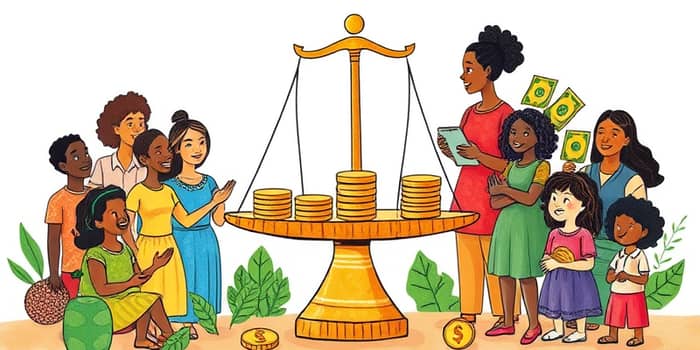
Responsible credit practices are the backbone of a resilient economy. When lenders and borrowers act with integrity and foresight, they spark growth, innovation, and social stability.
Without a foundation of trust and prudence, credit can become a cycle of debt that undermines families, businesses, and entire communities.
At its core, responsible lending and borrowing involves extending and taking on credit in ways that safeguard long-term financial health. It ensures consumers can meet needs, businesses can invest, and economies can flourish without undue risk.
By minimizing risk and supporting long-term financial well-being, societies create a virtuous cycle: healthy cash flows lead to job creation, increased spending, and improved quality of life.
In the United States alone in 2023, small-dollar loans outstanding reached a staggering $1.4 billion across 2.7 million loans tracked by credit bureaus. These figures underscore the demand for quick credit among many households navigating unexpected expenses.
Payday lending remains a prominent part of this market. In 2022, borrowers paid over $2.4 billion in fees on payday loans across thirty states, with nearly 20 million new loans issued totaling approximately $8.6 billion in principal.
Many payday borrowers have annual incomes near $30,000 and take out an average of ten small loans per year, each averaging $390–$400. Given a typical APR of 196%, a $400 loan rolled over multiple times can generate up to $301 in fees and interest—nearly matching the original loan amount.
Beyond payday products, millions of Americans remain credit invisible or subprime. For these individuals, obtaining fair credit is challenging, pushing some toward higher-cost options and deepening financial exclusion.
Frequent reborrowing is common among payday loan app users. Within a year, borrowers may double their monthly loan count from two to four, and over 40% borrow from multiple apps simultaneously. This practice deepens financial distress and compounds fees.
On average, heavy payday loan app users pay $421 per year in combined loan and overdraft fees—over three times the cost incurred by moderate users and six times more than light borrowers. Such charges can exhaust limited household budgets, leaving little for essentials like food, rent, or healthcare.
Imagine a single parent who turns to a payday loan to cover rent after an unexpected car repair. The initial relief soon gives way to anxiety as fees accumulate, forcing repeated borrowing and eroding any sense of financial control.
The broader economic impact is profound. When low-income communities serve as net cash outflows to payday lenders, local businesses lose customers, economic mobility stalls, and social inequalities widen.
Fortunately, examples of examples of responsible credit alternatives abound. Twenty states plus the District of Columbia enforce strict usury laws, capping APRs for small loans at 36% or less. These caps shield borrowers from crippling interest while maintaining access to emergency funds.
Community Development Financial Institutions (CDFIs), credit unions, and select fintech firms have built mission-driven models that integrate robust credit assessments with educational support.
Before approving loans, these institutions often perform affordability assessments and financial counseling to ensure borrowers can repay without undue hardship. One CDFI in the Midwest reports a default rate below 5%, compared to over 30% in the payday sector.
Technological innovation also plays a pivotal role. By incorporating alternative data—such as rent, utility, and mobile phone payments—into underwriting, lenders can more accurately gauge creditworthiness for individuals who lack traditional credit histories.
Flexible repayment schedules, linked to income flows, further reduce default risks and help borrowers stay on track. In several pilot programs, repayment flexibility cut default rates by nearly 40%.
States with 36% APR Caps
Responsible lending extends beyond retail markets into the realm of sovereign finance. The UN Conference on Trade and Development (UNCTAD) emphasizes that both creditors and debtors must practice transparency, prudence, and shared accountability in sovereign debt issuance and management.
International frameworks such as the Monterrey Consensus and the Addis Ababa Action Agenda call for robust debt sustainability analysis, clear disclosure of loan terms, and mechanisms for debt restructuring that protect vulnerable populations and maintain global financial stability.
The International Monetary Fund and World Bank have strengthened debt monitoring and transparency safeguards, urging member nations to publish comprehensive debt registers and engage in peer review exercises.
Regulators and policymakers wield critical tools for fostering responsible practices. Key measures include:
Enforcement is equally vital. Without dedicated regulatory oversight and meaningful penalties for noncompliance, even well-designed rules fail to protect consumers. Strong institutions must monitor, evaluate, and sanction errant lenders swiftly, especially those exploiting digital channels.
When credit flows responsibly, it fuels small business expansion, empowers households to navigate emergencies, and enhances community resilience.
Studies show that borrowers who access fairer loans spend more on local goods, invest in education, and contribute to stronger social networks. One rural cooperative lender reported a 25% increase in new business startups among clients over three years.
Conversely, over-indebtedness exacerbates social stratification. Families caught in endless repayment cycles often skip preventive healthcare, forego educational opportunities, and live with chronic stress. These outcomes not only diminish individual prospects but also increase long-term public costs in social services and healthcare.
The rapid rise of Buy-Now-Pay-Later (BNPL) platforms illustrates both promise and peril. BNPL can democratize access to credit for small purchases but often lacks transparent interest calculations and clear consumer protections, leaving some users exposed to hidden fees and late charges.
FinTech lenders face a similar paradox: as they innovate with machine learning-based underwriting and real-time repayment tracking, they can widen inclusion for credit-invisible consumers. Yet without robust safeguards, algorithmic biases and opaque fee structures may perpetuate unfair outcomes.
Policymakers must adapt regulatory frameworks to oversee these new products, ensuring they deliver on the promise of inclusion without sowing fresh debt traps.
Responsible lending and borrowing are more than ethical imperatives—they are practical engines of sustainable growth. By balancing access to credit with prudent risk management, societies can foster innovation, reduce inequality, and safeguard financial stability.
From local credit unions to global financial institutions, stakeholders share a collective duty: to advance practices that protect consumers, support businesses, and preserve the integrity of the economic system. When lenders extend credit with care and borrowers engage with discipline, the entire economy thrives.
Investing in transparent policies, robust oversight, and financial education today will yield resilient communities and a stronger economy for generations to come.
References





